

JACK ROUSH - 4/19/1942 -
Roush Fenway Racing (changed to RFK Racing in 2022)
Roush is the founder, CEO, and co-owner of Roush Fenway Racing, a NASCAR team headquartered in Concord, North Carolina, and is Chairman of the Board of Roush Enterprises. Roush Enterprises is the parent company for Roush Racing as well as Roush Industries, a freelance engineering firm, and Roush Performance, an automotive aftermarket development company. Rarely seen without his trademark Panama hat, Roush is known on the NASCAR circuit as "The Cat in the Hat". Roush was inducted into the International Motorsports Hall of Fame on April 27, 2006. Roush worked at Ford after graduating in 1966, and left in 1970 to pursue his own company. He worked for a year at Chrysler before leaving to open his own engineering business. Jack then went on to partner with Wayne Gapp to race in NHRA, IHRA, and AHRA drag racing events. Throughout much of his career Roush offered for sale the parts that he developed for his own team. In 1982, he partnered with German firm Zakspeed to develop road racing vehicles for Ford. This led to a very successful run in the Trans-Am series and IMSA Camel GT in the 80s and early 90s. In 1988, Roush moved south and founded a NASCAR Cup team now called Roush Fenway Racing with driver Mark Martin. He has had a successful career as an owner in all three of NASCAR's premier series. Roush came onto the scene in 1992 with Mark Martin as his driver. Martin would wheel a Roush machine full time though 2006. Rough functioned as a one car operation for the first four years, and had success. Martin was able to win five races in that span and finish third in
points in 1989; and better that with a second the following year. Roush expanded to a two car operation in 1992, adding Wally Dallenbach Jr to his his driving stable. Martin posted two wins; while Dallenbach was only able to post one Top 5 finish; it came at Watkins Glen. 1993 saw the same two drivers run for Roush. Martin had an impressive season, visiting victory lane on five occasions. He had a run of four straight wins in the second half of the season. Dallenbach almost pulled off his first win; finishing second at Watkins Glen; a race won by Martin. Although he had five wins; Martin could only manage a third place finish in the points standings. While not posting as many wins the following season; Martin would finish second in the points

Mark Martin 1990
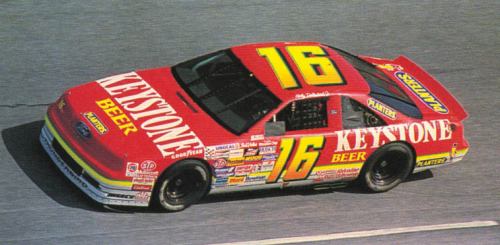
Wally Dallenbach 1993
on the strength of two wins and 15 Top 5 finishes. Unfortunately for Martin; Dale Earnhardt Sr would post four wins and 20 Top 5 results to claim the Championship. 1994 would see Dallenbach replaced by Ted Musgrave; but his results weren't much better than Dallenbachs as he only posted one Top 5 finish. 1995 saw a nice up-tick in performance for Roush Racing. Martin would claim four checkered flags, including a third straight win at Watkins Glen. Musgrave would finish twice and just get edged out of the win at Martinsville. He also posted seven Top 5 finishes. Both drivers finish well in the points standings.
On the strength of such a successful season; in 1996 Roush decided to branch out and add a third car to his team. Jeff Burton was tabbed o be the driver. The team suffered slight growing pains; going win-less for the first time since 1988. Martin performed the best coming in second and third on many occasions, and had 14 Top 5 finishes. Even with a "off" season Roush took the bold move to expand to a four car team the following year. He hired Chad Little to pilot his fourth car. Little had little success as he only had a best finish of 8th on the year. Jeff Burton broke through and got his first career win; and added two more before the season ended. Martin would win four times and finish third in the points. 1998 saw Roush go even larger and added a fifth car to his stable. Johnny Benson was hired to drive and posted three Top 5
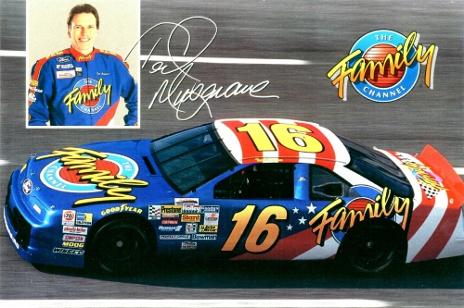
Ted Musgrave 1995
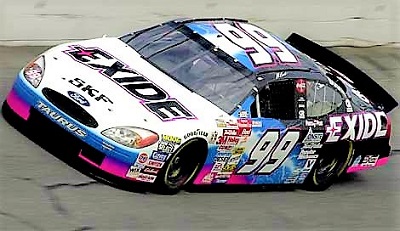
Jeff Burton 1998
finishes and 10 Top 10's Musgrave didn't fair much better posting five Top 5's while almost pulling off the win at Darlington. Musgrave was let go at mid-season and replaced by Kevin Lepage who had two Top 10's in only 13 starts. Burton had two wins for Roush; while Martin had a great season winning seven times. Jeff Gordon would have a phenomenal season posting 13 wins and and 26 Top 5's. Martin would finish second in the points once again; the third time he had done so. Roush had the seam five drivers he ended the season with return for 1999. He even had Matt Kenseth drive a sixth car on five occasions. Burton would have six wins this year and also give Roush his first "major" wins by claiming the
Checkers in the World 600 and Southern 500. Martin would only win twice; but on the strength of consistent finishes would again finish third in points. Benson, Lepage and Little could only post one Top 5 finish combined. The following year Kevin Lepage was released as a driver and Matt Kenseth was brought on board to take his place. He posted a win in the Coke 600, while Jeff Burton would have four wins and finish third in points. Martin would win once. Little was let go late in the season and Kurt Busch was brought in to run the last seven races. Busch was brought into the fold in full time in 2001 and Roush contracted back to a four car operation. His team now consisted of Burton, Busch, Kenseth and Martin. The operation had a dismal season and not one of the drivers was able to get to victory lane. Only the second time in Cup racing Roush had gone win-less. 2002 the team would rebound on the strength of ten wins. Busch would post
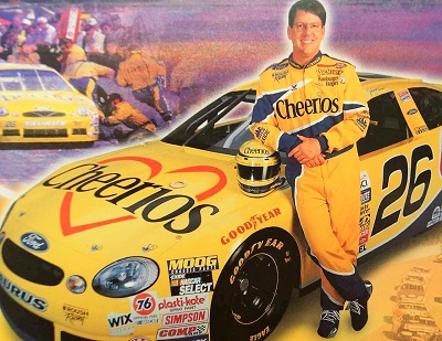
Johnny Benson 1998

Matt Kenseth 2003 Cup Champ
four wins; and Kenseth would win on five occasions. Martin would only win once; but it would come in the Coke 600; giving Roush his third win in the major event. Also on April 20, 2002, Roush almost lost his life when his private plane, an Aircam, went down in a lake in Troy, Alabama. Roush was underwater and unconscious, suffering from a head concussion, when Larry Hicks, a retired Marine in a nearby boat, rescued Roush from under water, pulled him to safety, and administered CPR. Shortly afterwards, Roush was flown to UAB Hospital in Birmingham, Alabama where he was treated for a head injury, broken ribs, and a shattered left leg. Hicks was injured as a result of the rescue, suffering cramps in both his arms and first degree chemical burns on his body from the fuel. In 2003, on the strength of many Top 5 finishes Martin would again finish second in the points; this time to Tony Stewart. With a strong group of drivers; Roush once again expanded out to five full time cars for 2003. He added Greg Biffle to drive
the additional car. Biffle produced off the bat; claiming a win in his first year with Roush. Burton and Martin had an off year as both went win-less. But it was not a total loss as Busch would claim for wins while Kenseth would claim the Championship. The first for Cup Championship Roush. The following year the organization kicked off the season with Biffle, Burton, Busch, Kenseth, and Martin as their drivers. Toward the end of the season Burton and Roush parted ways and a young Carl Edwards was brought on to finish out the season. Biffle and Kenseth both claimed two wins while Martin added one. Kurt Busch had four wins and a strong season led him to claim the Cup Championship; the second in a row for Roush. The same
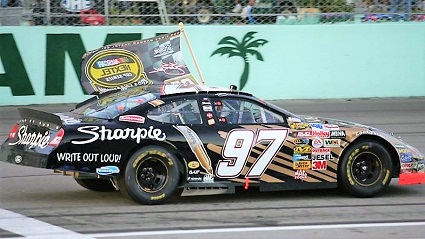
Kurt Busch 2004 Cup Champ
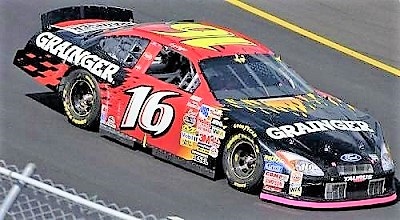
Greg Biffle 2006
stable of five drivers returned in 2005 and posted 15 wins for the Roush Organization. Biffle won the "Southern 500" (now move to the spring and renamed the Dodge Charger 500) and added five more wins. Carl Edwards had an impressive rookie season visiting victory lane four times; while Kurt Busch had three wins and Kenseth and Martin added one each. Kurt Busch and Roush parted ways with just two races to go in the season and Kenny Wallace was brought in to run those races. Jamie McMurray was take Busch's seat the following year Roush's other four drivers all returned. Kenseth would grab the checkered flag four times and finish second in the points; while Biffle added two more wins. The rest of the stable would be shut out.
After 19 seasons Mark Martin would depart the Roush team. David Ragan was brought on to fill his seat. He was the only driver not to post a win; and only had two Top 5 finishes. Edwards had three wins; the most on the team but could only get an eighth place finish in points. Kenseth won twice while McMurray and Biffle had one win each. The same crew came back for 2008 with Edwards having an impressive season. He posted nine wins; but Jimmie Johnson would edge him out for the Championship. Biffle would have the teams only other two wins and finish third in points. 2009 was not a good year for Roush. Kenseth managed two wins; but one of them gave Roush his first Daytona 500 victory. McMurray got the other win. In 2010 due to new NASCAR rules Roush had to cut back to a four car team. NASCAR had implemented a rule that no one
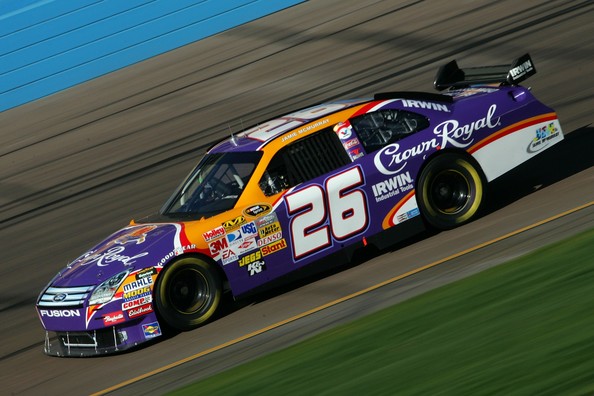
Jamie McMurray 2009
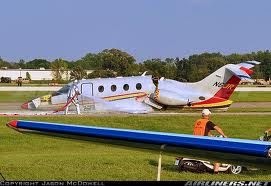
owner could have more than four cars. Thus McMurray left Roush and went to drive for Earnhardt-Ganassi Racing. Biffle and Edwards both posted two victories but could only muster a sixth and fourth in points respectively. Kenseth had a best finish of second (twice) and ended up fifth in points. In 2007 Roush had another brush with death. On July 27, 2010, Roush crash-landed in his Hawker Beechcraft Premier 390 jet during an approach to the Experimental Aircraft Association (EAA) AirVenture Fly-In in Oshkosh, Wisconsin in the late afternoon. He walked out of the plane and was taken to a nearby hospital. His condition was listed at serious but stable that evening. On August 3, Roush was upgraded to fair condition. On August 13, Roush made his first at track appearance since the incident at the Michigan International Speedway. During
that time he confirmed that he fractured his back, broke his jaw, and lost his left eye as a result of the crash. David Ragan won his first race for Roush in 2011; but only finished 23rd in points. Edwards would win once but almost won the Championship. At the season final race Edwards and Tony Stewart ended up tied in the points. Stewart won the race; while Edwards finished a close second. Stewart claimed the Championship with the tie breaker (most wins). Kenseth won three times, but was fourth in points. David Ragan would be cut loose from Roush in 2012 while Ricky ran four races in the teams fourth car. Kenseth would win the Dayton 500 and have an additional two victories. Biffle also won twice. The following year Kenseth left Roush to go drive for Joe Gibbs Racing. Stenhouse was brought on board full time to take Kenseth seat. About this time Roush's organization started to take a down-turn. Edwards won twice that year; and it

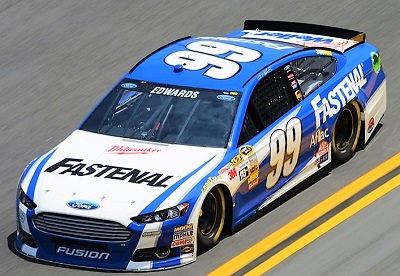
Carl Edwards 2012 Daytona
was the only two wins the organization had. Biffle and Stenhouse could only combine for four Top 5's. Edwards follow former team mate Kenseth to Joe Gibbs Racing in 2015. Roush brought in Trevor Bayne to fill the void. The organization continued it's downward slide. Biffle finished second in the Coke 600 that season; but all three drivers combined for a total of four Top 5 finishes. In 2016 the team went win-less again and Biffle was released at the end of the year. 2017 saw Roush again contract and was now just a two car team. Stenhouse managed to claim a win at Talladega and one at Daytona; and had four Top 5 finishes. Bayne had a dismal season posting only two Top 5's. For 2018 Roush has the same two drivers returning. Roush was also prominent in the Xfinity Series and also the Truck series. Roush got into the Xfinity series in 1992. Mark
Martin was his driver but since he was running the Cup Series full time only ran about half of the Xfinity races. Since he never ran the full season; he was never in contention for the points Championship. But he did rack up the wins... From 1992 through 2000 Martin would claim 39 wins; posting at least one win each season. Jeff Burton would join Martin as a team mate in 1997 and he would race for him through 2004. Like Martin, Burton would pile up the wins. Burton won 16 race through 2002, but went win-less his final two season with Roush. Greg Biffle was brought in to replace Martin at the end of the 2000 season. Biffle would be the first driver to run the full Xfinity Series for Roush. 2001 saw Biffle claim five wins that season and finish fourth in points. The following year
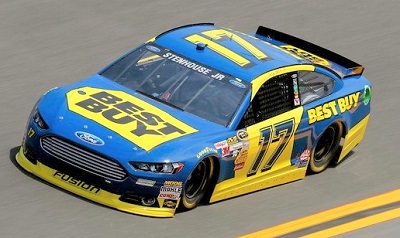
Ricky Stenhouse Daytona 500 2013
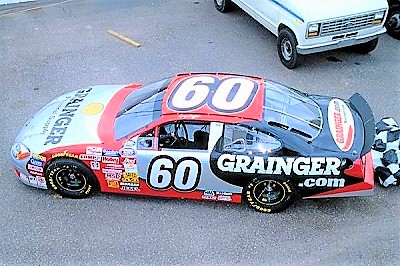
Greg Biffle - 2002 Xfinity Champ
he claimed four wins; but gave Roush his first Xfinity Championship. Biffle had five wins in 2004 but only finished third in points. Carl Edwards replaced Biffle as the teams full time driver the season; posted five wins and a third place finish in the points. The next season Edwards would improve to second in points. In 2007 Edwards would progress one more step up the ladder and win the Xfinity series Championship. Roush also had David Ragan wheel one of his Fords full time in the series; finishing fifth in points. Edwards and Ragan again ran the full 2008 season for Roush and even though Edwards posted seven wins; he finished second in points. Ragan would have a good season finishing fourth in points. 2009 and 2010 would see more of the same for Edwards, four or five wins but both years he again had disappointing seconds in the
Championship. Paul Menard and Ricky Stenhouse was brought in for the 2010 season as Roush expanded to three Xfinity teams. Menard and Stenhouse could only post seven Top 5 finishes combined. 2011 would see Trevor Bayne replace Menard as a full time driver. Edwards would grab eight wins this season; but missed one race knocking him out of contention for the Championship. Bayne also got a win for Roush in his first season, while Stenhouse visited victory lane twice. But his consistent finishes through out the season let him claim the Championship. Edwards quit driving the Xfinity Series full time so he could concentrate on his Cup races. Even with Bayne and Stenhouse as full time drivers now; Roush still had a great season. Bayne claimed a win; while Stenhouse would win six times and claim his second Championship.
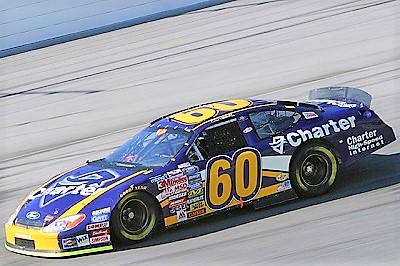
Carl Edwards 2007 Xfinity Champ
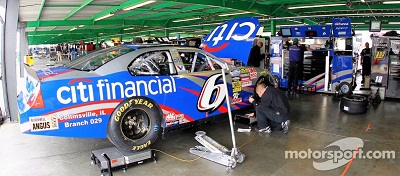
Ricky Stenhouse 2011 & 2012 Xfinity Champ
Stenhouse moved up to Roush's Cup team for 2013 and Travis Pastrana was hired to take the controls of his car. He only posted four Top 10 finishes and was released at the end of the year. Chris Buescher was tabbed to take over Pastrana's ride in 2014 as a team mate to Bayne; and Roush added a third car and put Ryan Reed in the seat. Only Buescher was able to get a win that season. The following year Bayne follow Stenhouse up to the Cup series driving for Roush and he was replaced by Elliott Sadler. Darrell "Bubba" Wallace was added to a fourth car.
All the drivers would finish in the Top 10 in points; with Buescher claiming the Championship. Only Reed and Wallace was brought back for the 2016 season as Roush pared his team down to just two cars. The duo could only post four Top 5 finishes that year. This coincided with Roush's organization down fall in the Cup Series. Roush again contracted the following year and only Reed would wheel a full time ride. He did get one win; but finish eighth in points. Roush got involved in the Truck Series in 1995. Joe Ruttman was his first full time driver (1996);

Chris Buescher 2015 Xfinity Champ

Greg Biffle 2000 Truck Champ
and gave Roush his first Truck Series win in 1997. Ruttman won on five occasions and finished third in points. Greg Biffle and Ruttman drove full time for Roush in 1998; but it was a down season as Ruttman posted the teams lone win. Biffle had a great season the following year capturing the checkered flag on nine occasions. But he finished second in the points getting edged out by Jack Sprague by eight points. Biffle would finally break through to claim the Championship in 2000; while team mate Kurt Busch would
finish second. 2001 through 2009 would see Roush's truck team take as down slide. Although he ran two trucks almost full time these years, and had quality drivers in the seat; his drivers only managed to get 22 wins. They only had a best finish of fourth in the points. Roush shut down his truck team at the end of 2009. Roush Fenway Racing continued to struggle trying to catch up and be competitive with the other top teams in the Cup series. Roush has really struggled since veteran Matt Kenseth left to go to Joe Gibbs Racing at the end of 2011; and Carl Edwards followed at the end of 2014. The only veteran left on the team was Greg Biffle and he was let go at the end of the
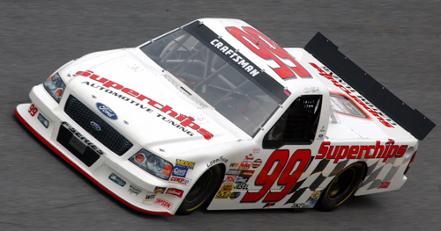
Carl Edwards 2003

Trevor Bayne 2018
2016 season as Roush contracted to make a smaller team. Like in 2017 Ricky Stenhouse and Trevor Bayne were the team drivers for RFR. Neither had any type of successful results. Bayne saw Matt Kenseth called out of retirement to drive Bayne's car and assess the race program in an effort to try and make them more competitive. Kenseth relayed all the knowledge he could on to the team; but for the most part told them that Bayne and Stenhouse's assessments of how the car was reacting was accurate. Kenseth did manage to provide two top ten finishes in his 15 starts with a seventh at Phoenix and a sixth at the final race at Homestead. Stenhouse would have three top five
finishes in 2018 and finished 18th in the points. Roush decided changes had to be made for 2019. So while Stenhouse is returning for the 2019 season, Bayne was let go and Ryan Newman was hired to drive the #6 car in 2019. Also the Xfinity series team was shut down to concentrate more on their Cup efforts. As for Newman, he almost won at Talladega as he was just edged out by Ryan Blaney. The second place finish would be an improvement for RFR, and Newman added two fifth place finishes. For the season Newman had 14 Top 10 results. This was a huge improvement over the results other Roush's drivers had been able to post over the last several seasons. Stenhouse had an even worse season in 2019 than he had in 2018. This season he only posted one Top 5 finish; it being a fifth in the Coke 600. He only had three
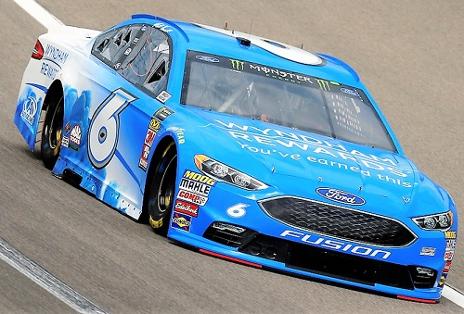
Matt Kenseth 2018
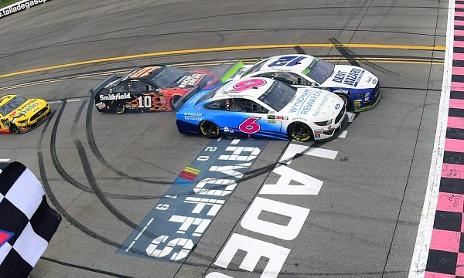
Ryan Newman (#6) second at Talladega 2019
Top 10's. Stenhouse only had 21 Top 20 finishes as he struggled all season long. It was too much for Roush to take and announced late in the season that Stenhouse would be let go at the season's end. He picked up Chris Buescher to drive the #17, but he didn't show any improvement over what Stenhouse had done. Buescher originally came into the NASCAR series under the leadership of Roush, but he let him get away. Jack had always wanted to get Buescher back under their banner and this was a great opportunity. Ryan Newman almost pulled off a win in the Daytona 500. On the final lap he was leading coming off the final corner. He went high to block the run coming by Denny Hamlin; that give Ryan Blaney a run on the inside and Newman moved to block
that. Blaney run into the back of Newman and it turned him into the outside wall in front of the oncoming field. He flew up into the air, turned upside down and while in the air was struck in the drivers window by Corey LaJoie. The racing community held it's breath as rescue personnel rushed to the crash site to check on Newman. He was removed and immediately rushed to the hospital. Very little news was available and many who saw the crash feared Newman would die. But, unbelievably Newman walked out of the hospital under his own power two days later. He missed the next three races as he was waiting for his concussion to heal and NASCAR to clear him to drive
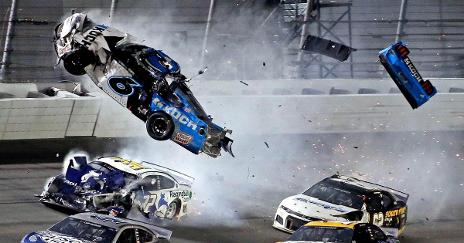
Ryan Newman Daytona crash 2020
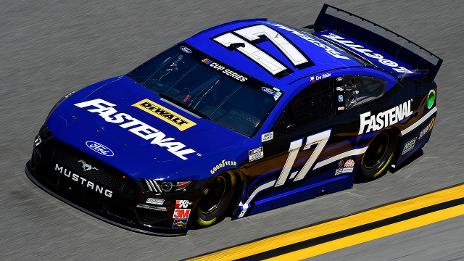
Chris Buescher 2020
again. Roush put Ross Chastain in his place. The coronavirus pandemic struck after race four of the NASCAR season, and by the time the season resumed Newman was set to start racing again. He had a rough season with a best finish of sixth at Talladega and only two Top 10 results. It was clear Roush's race program was still behind the top tier teams. He had twelve finishes inside the Top 15 and 19 finishes in the Top 20. The two drivers will be back in 2021, and undoubtedly RFR is looking forward to 2022 when the NextGen car come out and they should be on more of an even footing with the rest of the race teams. Roush Racing has been struggling the past several years; and Buescher seems to be the lead driver.
For some reason the team can’t manage to run up front and compete for wins like it used to. But help may be on the way. Late in the season it was announced that Brad Keselowski would be leaving Penske Racing to move over to drive for RFR and also become part owner. On November 11, 2021; it was announced the new name would be Roush Fenway Keselowski Racing. (RFK Racing). For the season Chris Buescher seemed to be the lead driver. But even as lead driver he only manager to post seven Top 10 finishes; with a best of third at Charlotte on the Roval. Ryan Newman posted two Top 5’s but only five Top 10’s. Since Keselowski is moving to drive for Roush; he will drive the #6 car that Newman drove in the 2021
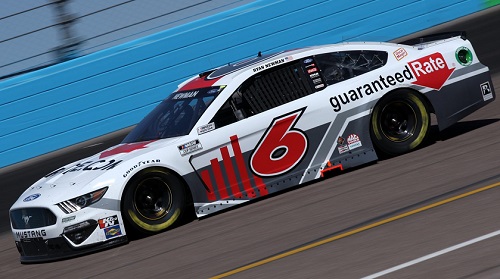
Ryan Newman Cup Series 2021

Brad Keselowski Cup Series 2022
season. Newman decided it was time to retire from full time racing. As Brad Keselowski left Team Penske at the end of 2021. he had high hopes of coming to RFK Racing to help solve their issues and get them back on the winning track. Of course; Keselowski was one of the full time drivers, along with Chris Buescher. Both the teams looked bad at times; and sometimes they would look fast and lead laps. It appeared when the season came to a close; the teams had made some gains on the other teams. Keselowski had his best finish of the entire year, ninth, coming in the season opening Daytona 500. SO hopes were certainly buoyed as the season started. Buescher
would also run well and finish 16th. Brad run well from time to time, but something would happen to see him finish outside the top ten. He had six top tens and 15 finishes inside the top 15. He ran best at Bristol when he led 109 laps. But a flat under green put him a lap down and he ended with a 13th place finish. Bad luck for Brad turned into good luck for his team mate Buescher. Chris had run a strong race, even leading over 100 consecutive laps before the mid-way point. He hung around the top ten all night and when the yellow flew with about 65 laps to go; Bueschers team got him out of the pits first. He held on to lead the final 61 laps and get his second career win. Buescher also showed a lot on strength on the road courses in 2022. He finished second at Sonoma, and added finishes of sixth at Road America, tenth on the Indy road course, ninth at Watkins Glen and sixth at the Roval.
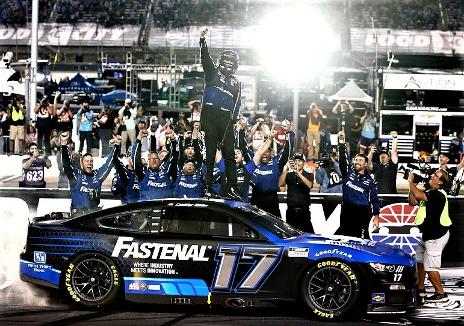
Chris Buescher 2022 Cup win Bristol
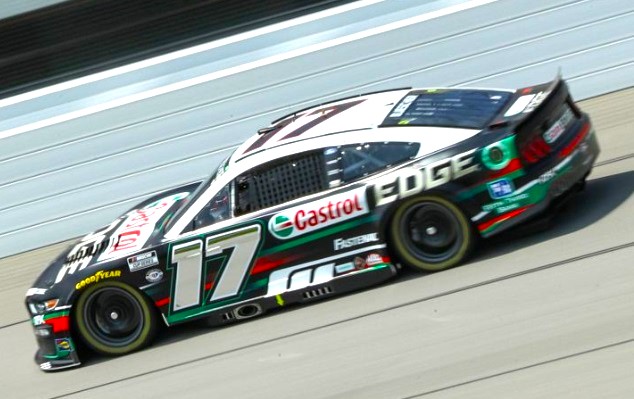
Chris Buescher Cup win - Michigan 2023
So he because a potential winner on the road courses. He also had top tens at Atlanta, Phoenix, Dover, and Richmond. A total of ten top tens on the season. Keselowski and Buescher was back at RFK in 2023 looking to add more wins to their totals. Keselowski moving to team with Roush looks to have shown some improvement. For the first time since 2013 the group managed to win three races. All three wins came at the hands of Chris Buescher. He started off slow, and only had three top five finishes the first 21 races. But he seemed to catch on fire at Richmond. He grabbed a win there and followed it up the next race at Michigan. Three weeks later, he was in victory lane again, this time at Daytona; just edging out team-mate Brad Keselowski. Buescher ran well in the
Chase, and advance through each round, but was eliminated just before the championship race at Phoenix. Meanwhile Keselowski wasn’t able to get a win, but ran better than in 2022. He finished second at Atlanta, and as mentioned at Daytona. Keselowski made the Chase via points, but was eliminated after the Round of 12. The group is looking for more improvement in 2024. Jack Roush has won six championships as a car owner in NASCAR's top three series. Two Cup titles (2003 with Matt Kenseth and 2004 with Kurt Busch), four Xfinity Series titles (2002, 2007, 2011 and 2012; and a Camping World Truck Series title in 2000. Jack has two Daytona 500 victories as a car owner, both with driver Matt Kenseth in 2009 and 2012. His drivers have won the Southern 500 and on three occasions (1993, 2005 and 2006); They have also won the Coke 600 four times (1999, 2000, 2001, 2002).
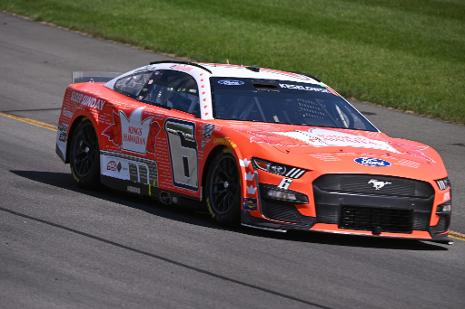
Brad Keselowski Cup ride 2023
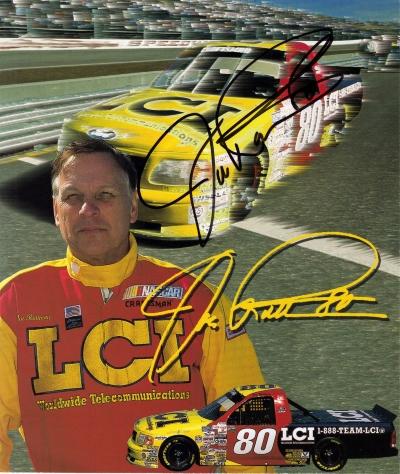
His career as a car owner shows he has owned cars that have competed in 3953 Cup events as of the end of 2023. He has 141 wins and 780 top fives. In the Xfinity series his drivers have made 1712 starts win 138 wins; and in the Truck Series his teams have 712 starts with 50 wins. Also ROUSH Performance sells a variety of vehicles, parts, and high-performance crate engines. Perhaps best known for the line of up-fitted Ford Mustangs, they have more than 16,000 vehicles on the roads today. Typical improvements on the base chassis include appearance packages (body kit, wheels, etc.), suspension and handling upgrades, and horsepower boosts through the use of a ROUSH charger supercharger system. ROUSH Performance sells versions of their Mustang with as much as 540 horsepower and 510 lb-ft of torque. Additionally, the company has expanded into offering propane-fueled vehicles designed for fleet usage. They have packages available to convert the Ford F-150/250/350 and E-150/250/350 vans. Propane is an excellent alternative fuel for fleets; it typically costs less than gasoline (especially when tax credits are implemented), is 90% produced in America which lessens American dependency on foreign oil, and burns substantially cleaner than gasoline or diesel. Some info from WikiPedia
All Photos copyright and are property of their respective owners
